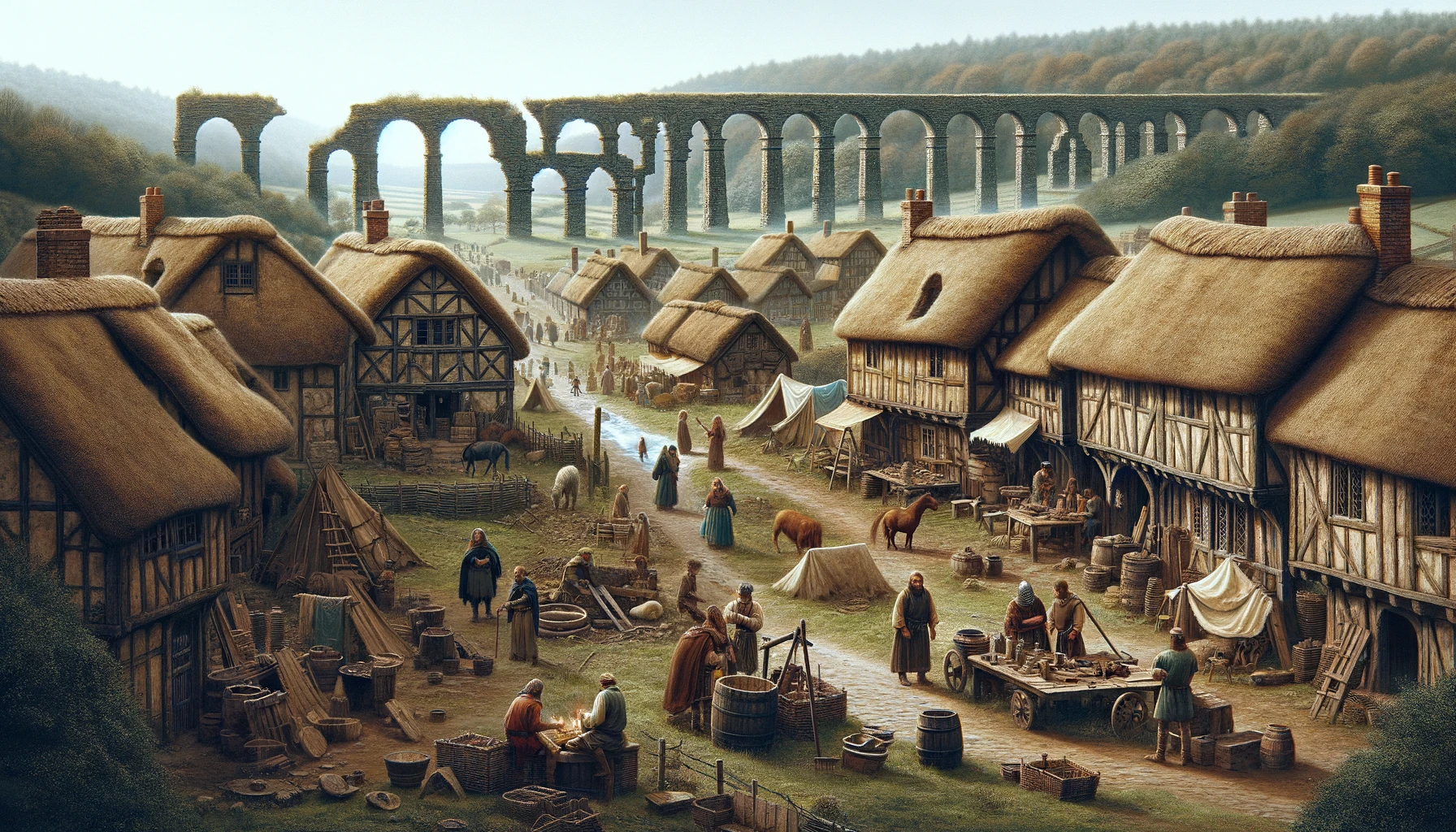The Fall of Roman Britain
The end of Roman rule in Britannia during the early 5th century was a complex and multifaceted process, involving internal power struggles within the Roman Empire and external pressures from various barbarian groups. According to Gildas the process started when Magnus Maximus (ruling from 383 to 388), a usurper, led troops away from the island for continental battles.
The Roman general Stilicho, who effectively ruled the Western Roman Empire, faced challenges from the aristocracy. To protect Italy from Visigothic invasions, Stilicho significantly weakened the empire’s defences along the Limes Germanicus by depleting its forces.
In 406 AD, the reduction of military forces in Britain led to a rebellion by Roman legionaries, resulting in the proclamation of several usurpers as emperor. This period of political unrest culminated in Constantine III, one of the usurpers, crossing the Channel to Gaul and taking with him the remaining mobile troops from Britain, leaving the province without its primary military defences.
Simultaneously, the Vandals, Burgundians, Alans, and Sueves crossed the Rhine and overran the Limes Germanicus. By 408, Britain faced barbarian raids which were reportedly repelled. Around 410, Emperor Honorius is said to have instructed the cities of Britain to fend for themselves, signalling the formal end of Roman support, although the authenticity of these letters is sometimes disputed.
The Rise of the Kingdoms
From the mid-5th century, Germanic raiders began settling in the eastern river valleys. Subsequent civil conflicts have been interpreted variously, including as clashes between pro-Roman and independence factions, disputes between the “Established Church” and Pelagian groups, class struggles between peasants and landowners, or as a coup orchestrated by an urban elite.
This period saw the rise of local Celtic military leaders, often surrounded by their armed entourages, engaging in raids on the territories of their adversaries. Gildas harshly criticizes these rulers as ‘tyrants,’ accusing them of looting, initiating unjust internal conflicts, and favoring criminals as allies, describing them as “bloody, proud, and murderous men, adulterers, and enemies of God.” He specifically mentions Maelgwn Gwynedd, a prominent dux, to exemplify these leaders’ evolution into military chieftains, which eventually led to their acknowledgment as kings, or ‘reges.’
Rural life persisted largely unchanged, albeit on a smaller scale, while urban centres experienced decline, as evidenced by accounts of Germanus’ visits. The centrally governed Roman provinces were replaced by feuding kingships.
Vortigern
Around 447/449, amidst continuous barbarian invasions and the backdrop of a devastating plague, Britain faced a critical shortage of manpower. This situation led Vortigern, described by Nennius as a ‘proud tyrant’ from the southeast, to invite additional Saxons into the country, offering them land in exchange for their military aid. Initially, Vortigern granted them the Isle of Thanet, and eventually, the entirety of Kent was ceded to two Jutish exiles, brothers Hengist and Horsa, along with provisions and clothing. While this event is highlighted as a pivotal moment, it was, in fact, a conventional solution employed during the Late Roman era to address similar challenges. J.N.L. Myres, drawing on archaeological findings, has pointed out that Saxon mercenaries had been forming settlements, particularly in eastern Britain, as far back as the 3rd century.
As the Saxon presence in Britain grew, so too did their demands, leading to violent confrontations with the Romano-Britons that frequently ended in Saxon victories. These conflicts saw the Saxons capturing and destroying cities, and massacring their populations as they advanced through much of eastern, midland, and northern Britain. In response, many British survivors fled across the Channel to Brittany, including Gildas, while others withdrew to the west and north, seeking refuge in the more defensible forested and mountainous areas. This migration gave rise to their later designation as ‘Welsh’. An archaeological hallmark of this sub-Roman era in western Britain was the reinforcement of hillforts, notable examples being South Cadbury in Somerset and Irthlingborough near Northampton, indicating a strategic response to the encroaching threats.
Not every Saxon was an adversary to the Romano-Britons; indeed, some Saxons likely served within British military ranks up until around 490. Moreover, the Saxon military campaigns didn’t always end in their favour. Vortigern’s son, Vortimer, is noted for securing several victories against them in the early 450s, and Horsa met his demise in battle at ‘Aegelesthrep’ (identified with modern-day Aylesford, Kent). Nevertheless, around 460, Hengist is reported to have orchestrated a deceitful plot by inviting Vortigern and numerous British nobles to a banquet under the guise of negotiating peace, only for most of the guests to be slain in a treacherous act. Following this, the captured Vortigern was forced to cede significant territories.
Ambrosius Aurelianus
Gildas records a significant counteroffensive against the Saxons led by Ambrosius Aurelianus, a member of the prestigious Roman Aureliani family. Ambrosius, the child of a Roman officer and a British woman—both victims of the Saxon invasion—rallied the ‘citizens,’ as his supporters were termed, from their hiding spots to engage the Saxons in a fluctuating conflict. There’s mention of a feud between Ambrosius and Vortigern, with speculation that Vortigern may have perished in a civil conflict; Gildas recounts on-going disputes among British factions into the early 6th century (DEB, 27–32). Nennius (48) credits Ambrosius with the title Magnus Rex inter Reges Britanniae (‘Great King among the Kings of Britain’), hinting at efforts to consolidate Britons and the remaining Roman forces in Britain, such as the Equites Taifali in Lincolnshire, under one leadership. Ambrosius likely spearheaded the resistance in the west, exercising direct control over the territories that remained staunchly Romano-British, spanning from the Channel to Hadrian’s Wall. In Welsh tradition, he is known as Emrys Wledig.
King Arthur
The question of his real existence, identity, and status might forever remain unresolved, yet there’s a broad agreement among scholars that after Ambrosius, a leader known as Artorius or ‘Arthur’ waged battles against the Saxons in the early 6th century. He is celebrated for leading “all the kings and military force of Britain” (militibus Britanniae) to victory in 12 battles, as recorded in historical texts. Contemporary research portrays him as a Romano-Celtic chieftain, likely honoured with the title Dux Bellorum (‘war-leader’), spearheading armoured cavalry units against the Saxon invaders, akin to a Late Roman cavalry general as noted by Collingwood. Gildas highlights his most significant triumph at the battle of Badon Hill, the twelfth victory attributed to him by Nennius, marking a pivotal moment in the Romano-British resistance against the Saxons initiated by Ambrosius. This battle, described by Gildas as the siege of a hill, signified a critical Romano-British win, stalling Anglo-Saxon advances for nearly half a century. This hiatus, also evidenced by archaeological findings, has been linked by some scholars to catastrophic global climate events that caused widespread famine and disease. Despite some challenges to the authenticity of these British victories based on their later (9th- and 10th-century) sources such as the Historia Brittonum and the Annales Cambriae, the regions under British control continued to wield considerable political, economic, and military influence into the 6th.
The 6th Century
In his Latin writings, around 540, Gildas provides a historical account of Britain, though the earlier portion is notably confused. He condemns five rulers in western Britain – Constantine of Dumnonia, Aurelius Caninus, Vortipor of the Demetae, Cuneglasus, and Maglocunus (Mailcun or Maelgwn of Gwynedd in later spellings) – for their transgressions. He also criticizes the British clergy and offers insights into British customs, attire, and pastimes. Gildas mentions Britons being killed, emigrating, or enslaved but offers no specific figures.
In the late 6th century, another phase of Saxon expansion commenced, marked by the seizure of Searoburh in 552 by the dynasty that would later govern Wessex. This period also saw Saxon ingress into the Cotswolds region following the Battle of Deorham in 577, although the veracity of the Anglo-Saxon Chronicle entries for this era has been contested. Some modern scholars, without clear evidence, suggest that these conquests may have created a division between the Britons of South West England (later known as the West Welsh) and those of Wales. It is speculated that the Battle of Chester in 611, occurring shortly after the period under discussion, might have further separated the latter from the Britons of the north of England. Until the 570s, Britons retained control over roughly half of England and Wales.




